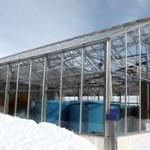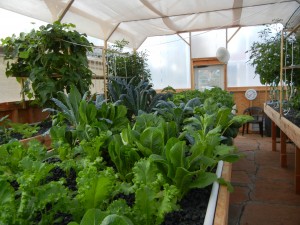Aquaponics in COLD Climates is Ideal for Greens
– by Colle and Phyllis Davis
 The key to the success of aquaponics in cold climates is the climatically adapted structure housing the installation.
The key to the success of aquaponics in cold climates is the climatically adapted structure housing the installation.
In tropical and warm climate installation, less planning and careful construction are required for success, but even in very cold climates, aquaponics can be very productive. It is the extra attention to details including insulation, heating, ventilation and backup or duplication of the electrical power that ensure success.
First, here’s some information regarding insulation. It is much easier to HEAT up space than to COOL it off. The laws of physics are in play here. Heat moves to areas where there is less heat or lack of heat. To create an insulated space and keep the air temperature inside that space at a reasonable level is easily accomplished and has been done for centuries. Today, the use of high R factor insulation, excellent sealing, and wind-proofing can produce a space with a very high R factor which means very little additional energy is needed to heat the space.
 The other benefit of the Portable Farms® Aquaponics Systems is their wide range of temperature tolerance. Space at the Grow Table level needs to stay in the range of 45 to 104° F (6 to 40° C). The Fish Tank is heated to a constant temperature and helps maintain the temperature inside through the timing of the water cycles.
The other benefit of the Portable Farms® Aquaponics Systems is their wide range of temperature tolerance. Space at the Grow Table level needs to stay in the range of 45 to 104° F (6 to 40° C). The Fish Tank is heated to a constant temperature and helps maintain the temperature inside through the timing of the water cycles.
Heating the space can be as simple as adding a small space heater that is placed on the floor. It can be electrical, propane, city gas or even fuel oil powered. Exhaust from combustion needs to be vented as in living space. There are installations measuring 20’ x 36’ (6 x 11m) in Minnesota that only require a small thermostatically controlled electrical heater to keep the space above 45 degrees. There are larger installations in Wisconsin, Oregon and New York heated with wood-burning stoves. These stoves are a lot more work, but work they do in producing great vegetables.
Even in cold climate installations, ventilation of the space must be addressed to reduce humidity and pockets of stale air. Every installation requires a small circulating fan to mix the air and ensure the air is moving. This air movement helps the pollination of the flowering plants (for example, tomatoes) and keeps any dampness at bay. Venting the air to the outside in very cold weather is seldom necessary. The smart method of having a growing space in cold climates is to attach the greenhouse to your house. The heat from the house helps temper the air in the greenhouse, and the plants give much-needed moisture to the winter air in the house.
Cold climate aquaponics does require more planning, better and more careful construction and the added expense of the backup heating and power requirements. Now is the time to plan, construct and begin to enjoy aquaponics no matter where you live.

6 comments
Skip to comment form
I have a high tunnel 20′ x 36′ which houses six 2′ x 10′ grow raised beds on one side occupying 12′ x 25′ space.
The other 8′ x 36′ empty space is set aside for portable Aquaponic equipment.
I tumbled on your website and getting to know what you are offering.
I am 73 year old male with my wife originally from India migrated here in 1995. Have no income other than $800.00 social security. Renting a house for $750.00 a month in rural Madison county, Ohio. In the property we were able to build athe above high tunnel and a low tunnel 6′ x 150 feet long at six feet high.
In both the tunnels we grow vegetables, greens during the growing season Aprilto September and market the produce through Local Farmers Market.
From October to March six months nothing growing due to lack of heat in the tunnels as well as no market outlet.
I am wondering if you have some input for starting a backyard Aquponics to try making some thing for our survival.
Please let me know what you can offer and guidance to shift my energies to Aquaponics low key enterprise to begin with.
Blessings to you,
Ananda R Musunuri
Author
Ananda,
You have done a great job with what you had available. You can extend your season by three to four months, but you need to have a market for your production or it is a waste of time.
Find your market and see what they would like you to produce. Depending on the orientation of the axis of the greenhouses, you can insulate the north side and most of the east and west walls. Use 55 gallon drums of water to absorb the heat during the day and keep the plants from freezing at night.
If you use catfish and cold weather crops you can harvest at least until the hard frosts and daytime highs in the low 40’s. You can also start you seedlings in February to get a huge start on the local markets. Get your market in place and then talk to us again on going w/aquaponics. The set up is not cheap so make sure you can get your return on investment in less than 5 years or don’t do the project.
Starting small, killing a few fish and plants, getting your hands wet all contribute to making this venture worth while.
Talk soon.
Colle
Do any of these books actually give building plans and layouts for a climately adapted greenhouses?
Ryan
Author
Ryan,
The GOLD series books are about the aquaponics technology. The requirements for a climatically adapted structure are covered in detail but because everyone wants something different in a greenhouse we have made plans available on the order page for a book specifically on greenhouse plans.
Colle
Here in North Texas we see temps in the teens. Is there an economical way to heat the fish tank
I could knit little sweaters for the tilapia but they won’t take care of them
Author
Oscar,
The AU Course covers this in detail. Basically you insulate the Fish Tank and we show you how to use an inexpensive and low tech way to heat the tanks to the perfect Tilapia temperature. You’re right, the training program for the sweaters would be brutal.
Colle